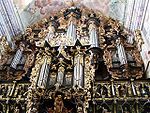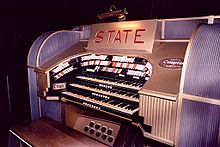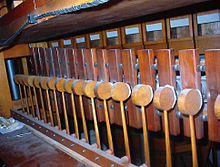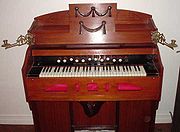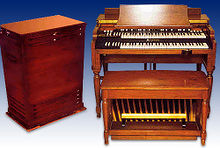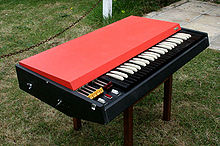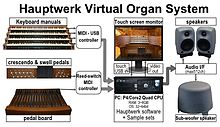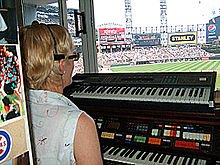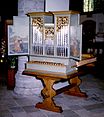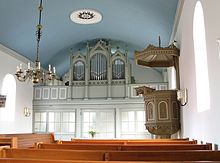- Organ (music)
-
Organ 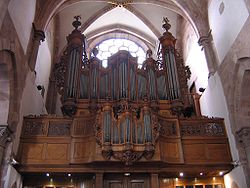
1741 Pipe organ in Église Saint-Thomas, Strasbourg, France.Classification Keyboard instrument (Aerophone) Playing range Related instruments see Keyboard instrument Musicians see List of organists Builders see List of pipe organ builders and category:Organ builders More articles Pipe organ · Theatre organ · Electronic organ · Hammond organ · Reed organ · Organ repertoire The organ (from Greek όργανον organon, "organ, instrument, tool"),[1] is a keyboard instrument of one or more divisions, each played with its own keyboard operated either with the hands or with the feet. The organ is a relatively old musical instrument in the Western musical tradition,[2] dating from the time of Ctesibius of Alexandria who is credited with the invention of the hydraulis. By around the 8th century it had overcome early associations with gladiatorial combat and gradually assumed a prominent place in the liturgy of the Catholic Church; subsequently it has re-emerged as a secular and recital instrument.
Contents
Overview
Pipe organs use wind moving through pipes to produce sounds. Since the 16th century, pipe organs have used various materials of pipes, which can vary widely in timbre and volume. The pipes are divided into ranks and controlled by the use of hand stops and/or combination pistons. Although the keyboard is not expressive as on a piano and does not affect dynamics (pressing a key only turns the sound on or off), some divisions may be enclosed in a swell box, allowing the dynamics to be controlled by shutters. Some special registers with free reed pipes are expressive. These instruments vary greatly in size, ranging from a cubic yard to a height reaching five floors,[3] and are built in churches, synagogues, concert halls, and homes. Small organs are called positive (i. e. easily placed in different locations) or portative (small enough to carry while playing). Increasingly hybrid organs are appearing in which pipes are augmented with electronic additions. Great economies of space as well as cost are possible especially when the lowest (and largest) of the pipes can be replaced.
Non-piped organs include the reed organ or harmonium, which like the accordion, harmonica or mouth organ use air to excite free reeds.
Electronic organs or digital organs generate electronically produced sound through one or more loudspeakers. .
Mechanical organs include the barrel organ, water organ, and Orchestrion. These are controlled by mechanical means such as pinned barrels or book music. Little Barrel organs dispense with the hands of an organist and bigger organs are powered in most cases by an organ grinder or today by other means such as an electric motor.
Pipe organs
The pipe organ is the grandest musical instrument in size and scope, and has existed in its current form since the 14th century (though other designs, such as the hydraulic organ, were already used in Antiquity). Along with the clock, it was considered one of the most complex human-made creations before the Industrial Revolution. Pipe organs range in size from a single short keyboard to huge instruments with over 10,000 pipes. A large modern organ typically has three or four keyboards (manuals) with five octaves (61 notes) each, and a two-and-a-half octave (32-note) pedal board.
Wolfgang Amadeus Mozart called the organ the "King of instruments".[4] Some of the biggest instruments have 64-foot pipes (a foot here means "sonic-foot", a measure quite close to the English measurement unit), and it sounds to an 8 Hz frequency fundamental tone. Perhaps the most distinctive feature is the ability to range from the slightest sound to the most powerful, plein-jeu impressive sonic discharge, which can be sustained in time indefinitely by the organist. For instance, the Wanamaker organ, located in Philadelphia, USA, has sonic resources comparable with three simultaneous symphony orchestras. Another interesting feature lies in its intrinsic "polyphony" approach: each set of pipes can be played simultaneously with others, and the sounds mixed and interspersed in the environment, not in the instrument itself. (Contrast this with digital organs, where the electronically produced sound comes from loudspeakers.)
Church organs
Most organs in North America, South America, Europe, Australia and New Zealand can be seen in Christian churches or Jewish synagogues. Therefore is generally called a church organ. The introduction of church organs is traditionally attributed to Pope Vitalian in the 7th century. Due to its ability to simultaneously provide a musical foundation below the vocal register, support in the vocal register, and increased brightness above the vocal register, the organ is ideally suited to accompany human voices, whether a congregation, a choir or a cantor or soloist. Most services also include solo organ repertoire for independent performance rather than by way of accompaniment, often as a prelude at the beginning the service and a postlude at the conclusion of the service.
Today this organ may be a pipe organ (see above), a digital or electronic organ that generates the sound with Digital Signal Processing (DSP) chips or a combination of pipes and electronics. It may be called a church organ or classical organ to differentiate it from the theater organ, which is a different style of instrument. However, as classical organ repertoire was developed for the pipe organ and in turn influenced its development, the line between a church and a concert organ is hard to draw.
Organs are also used to give recital concerts, called organ recitals. In the early 20th century, symphonic organs flourished in secular venues in the United States and UK, designed to replace symphony orchestras by playing transcriptions of orchestral pieces. Symphonic and orchestral organs largely fell out of favor as the Orgelbewegung (Organ Reform Movement) took hold in the middle of the 20th century and organ builders began to look to historical models for inspiration in constructing new instruments. Today, modern builders construct organs in a variety of styles and for both secular and sacred applications.
Chamber organs
A chamber organ is a small pipe organ, often with only one manual, and sometimes without separate pedal pipes that is placed in a small room, that this diminutive organ can fill with sound. It is often confined to chamber organ repertoire, as often the organs have too little voice capabilities to rival the grand pipe organs in the performance of the classics. The sound and touch are unique to the instrument, sounding nothing like a large organ with few stops drawn out, but rather much more intimate. They are usually tracker instruments, although the modern builders are often building electropneumatic chamber organs.
Theatre organs
The theatre organ or cinema organ was designed to accompany silent movies. Like a symphonic organ, it is made to replace an orchestra. However, it includes many more gadgets, such as percussion and special effects, to provide a more complete array of options to the theatre organist. Theatre organs tend not to take nearly as much space as standard organs, relying on extension and higher wind pressures to produce a greater variety of tone and larger volume of sound from fewer pipes.
This extension is called "unification", meaning that instead of one pipe for each key at all pitches, the higher octaves of pitch (and in some cases, lower octaves) are achieved by merely adding 12 pipes (one octave) to the top and/or bottom of a given division. Assuming there are sixty-one keys on an organ manual (a common number in concert organs and in North America), a classical organ will have, for diapason stops at 8', 4' and 2' pitch, a total of 183 pipes (61 plus 61 plus 61). The same chorus of diapasons on a theatre organ will have only 85 pipes (61 plus 12 plus 12). Some ranks, such as the Tibia Clausa, with up to 97 pipes, allow the organist to draw stops at 16', 8', 4', 2', and mutations from a single rank of pipes.
Unification gives a smaller instrument the capability of a much larger one, and works well for monophonic styles of playing (chordal, or chords with solo voice). The sound is, however, thicker and more homogeneous than a classically designed organ, and is very often reliant on the use of tremulant, which has a depth greater than that usually found on a classical organ. Unification also allows pipe ranks to be played from more than one manual and the pedals.
Other pipe organs
The bamboo organ called Bambuso sonoro is an experimental custom-made instrument designed by Hans van Koolwijk. The instrument has 100 flutes made of bamboo.[6]
A harmonium. Operation of the two large pedals at the bottom of the case supplies wind to the reeds.Reed organs
The reed organ and harmonium was the other main type of organ before the development of electronic organs. It generated its sounds using reeds similar to those of a piano accordion. Smaller, cheaper and more portable than the corresponding pipe instrument, these were widely used in smaller churches and in private homes, but their volume and tonal range was extremely limited, and they were generally limited to one or two manuals, pedalboards being extremely rare.
Chord organs
The chord organ was invented by Laurens Hammond in 1950.[7] It provided chord buttons for the left hand, similar to an accordion. Other reed organ manufacturers have also produced chord organs.[8]
Electronic organs
Since the 1930s, pipeless electric instruments have been available to produce similar sounds and perform similar roles to pipe organs. Many of these have been bought both by houses of worship and other potential pipe organ customers, and also by many musicians both professional and amateur for whom a pipe organ would not be a possibility. Far smaller and cheaper to buy than a corresponding pipe instrument, and in many cases portable, they have taken organ music into private homes and into dance bands and other new environments, and have almost completely replaced the reed organ.
Hammond organs
The Hammond organ was the first successful electric organ, released in the 1930s. It used mechanical, rotating tonewheels to produce the sound waveforms. Its system of drawbars allowed for setting volumes for specific sounds, and it provided vibrato-like effects. The drawbars allow the player to choose volume levels of 0-8 for each of the members of the harmonic series starting from 16'. By emphasizing certain harmonics from the overtone series, desired sounds (such as 'brass' or 'string') can be imitated. Generally, the older Hammond drawbar organs had only preamplifiers and were connected to an external, amplified speaker. The Leslie speaker became the most popular, which is a rotating type speaker. The three most popular models of Hammond organs were the consoles: the B-3, C-3, and A-100. Inside all three models, the tone generators, drawbars, and keyboards were identical. The B-3 cabinet stood on 4 legs, the C-3 was an enclosed "church" model, and the A100 series had built in amplifiers and speakers.
In addition to these console models, Hammond also produced spinet models, which differed from the consoles in the size of keyboard (44 keys per keyboard versus 61 for the consoles, and 12 or 13 pedals instead of 25) and the absence of foldback and scaling in the keyboards making them cheaper to manufacture. Other features of the console organs such as vibrato or percussion were included in the spinets; all the spinet models featured a built in amplifier and speaker; when used with the external amplified speaker (e.g.: Leslie) they sound similar to the console models. These smaller all-in-one organs were intended primarily for use in homes or very small churches.
Though originally produced to replace organs in the church, the Hammond organ, especially the model B-3, became popular in jazz, particularly soul jazz, and in gospel music. Since these were the roots of rock and roll, the Hammond organ became a part of the rock and roll sound. It was widely used in rock and popular music during the 1960s and 1970s by bands like The Doors, Pink Floyd, Procol Harum, Santana and Deep Purple. Its popularity resurged in pop music around 2000, in part due to the availability of clonewheel organs that were light enough for one person to carry.
Other electronic organs
Frequency divider organs used oscillators instead of mechanical parts to make sound. These were even cheaper and more portable than the Hammond. They featured an ability to bend pitches.
In the 1940s until the 1970s, small organs were sold that simplified traditional organ stops. These instruments can be considered the predecessor to modern portable keyboards, as they included one-touch chords, rhythm and accompaniment devices, and other electronically assisted gadgets. Lowrey was the leading manufacturer of this type of organs in the smaller (spinet) instruments.
In the '60s and '70s, a type of simple, portable electronic organ called the combo organ was popular, especially with pop and rock bands, and was a signature sound in the pop music of the period, such as The Doors, Led Zeppelin, and Iron Butterfly. The most popular combo organs were manufactured by Farfisa and Vox.
Conn-Selmer and Rodgers, dominant in more larger instrument market, also made electronic organs that used separate oscillators for each note, giving them a richer sound, closer to a pipe organ, due to the slight imperfections in tuning, by not using precise division.
Also available are hybrids, starting from early 20th century,[9] which incorporating a few ranks of pipes to produce some sounds, and using electronic circuits or digital samples for other sounds and to resolve borrowing collisions. Major manufacturers include Allen, Walker, Compton, Wicks, Marshall & Ogletree, Phoenix, Makin Organs, Wyvern Organs and Rodgers.
Digital organs
The development of the integrated circuit enabled another revolution in electronic keyboard instruments. Digital organs sold since the 1970s utilize additive synthesis, then sampling technology (1980s) and physical modelling synthesis (1990s) are also utilized to produce the sound.
Virtual Pipe Organs, played via MIDI, access samples of real pipe organs stored on a computer, as opposed to digital organs that use DSP and processor hardware inside a console to produce sounds or deliver sound samples. They have high polyphony (up to about 40,000 pipes/1PC), which is necessary as there is a sample for every single pipe on the organ, plus samples and modeling effects such as mechanical action noise and pipe wind fluctuations. Addition of touch screen monitors or custom midi controllers allows the user to control the virtual organ console (drawing stops, operating couplers etc.) In its basic form, without a traditional wooden console, a Virtual Organ can be obtained at a much lower cost than other digital classical organs. With Stereo or mulitple channel audio systems, virtual organs can approach the acoustic realism of a real pipe organ. For example, for most Virtual Organs with a pedal division containing 16 ft or 32 ft pipes, a subwoofer arrangement is required to reproduce the powerful movement of air at frequencies around 32 Hz or lower. For personal purpose, typically small studio quality near-field monitors with subwoofer are used.[10]
Steam organ
The wind can also be created by using pressurized steam instead of air. The steam organ, or calliope, was invented in the United States in 19th century. Calliopes usually have very loud and clean sound. Calliopes are used as outdoors instruments, and many have been built on wheeled platforms.
Organ music
Classical music
The organ has had an important place in classical music throughout its history. Antonio de Cabezón, Jan Pieterszoon Sweelinck, and Girolamo Frescobaldi were three of the most important composers and teachers before 1650. Influenced by these composers, the North German school then rose to prominence with notable composers including Dieterich Buxtehude and especially Johann Sebastian Bach, considered by many to have achieved the height of organ composition. During this time, the French Classical school also flourished.
After Bach, the organ's prominence gradually lost ground to the piano. Felix Mendelssohn, A.P.F. Boëly, and César Franck led a resurgence in the mid-19th century, leading a Romantic movement that would be carried further by Max Reger, Charles-Marie Widor, Louis Vierne, and others. In the 20th century, composers such as Marcel Dupré, Kaikhosru Sorabji and Olivier Messiaen added significant contributions to the organ repertoire.
Because the organ has both manuals and pedals, organ music has come to be notated on three staves. The music played on the manuals is laid out like music for other keyboard instruments on the top two staves, and the music for the pedals is notated on the third stave or sometimes, to save space, added to the bottom of the second stave as was the early practice. To aid the eye in reading three staves at once, the bar lines are broken between the lowest two staves; the brace surrounds only the upper two staves. Because music racks are often built quite low to preserve sightlines over the console, organ music is usually published in oblong or landscape format.
Soap operas
From their creation on radio in the 1930s to the times of television in the early 1970s, soap operas were perhaps the biggest users of organ music. Day in and day out, the melodramatic serials utilized the instrument in the background of scenes and in their opening and closing theme songs. Some of the best-known soap organists included Charles Paul, John Gart, and Paul Barranco. In the early 1970s, the organ was phased out in favor of more dramatic, full-blown orchestras, which in turn were replaced with more modern pop-style compositions.
Popular music
Church-style pipe organs are occasionally used in popular music. In some cases, groups have sought out the sound of the pipe organ, such as Tangerine Dream, and Arrogant Worms, which combined the distinctive sounds of electronic synthesizers and pipe organs when it recorded both music albums and videos in several cathedrals in Europe. Rick Wakeman of British progressive rock group Yes also used pipe organ to excellent effect in a number of the group's albums (including Close to the Edge and Going for the One). Wakeman has also used pipe organ in his solo pieces such as "Jane Seymour" from The Six Wives Of Henry VIII and "Judas Iscariot" from Criminal Record. Even more recently, he has recorded an entire album of organ pieces – Rick Wakeman at Lincoln Cathedral. Likewise, Keith Emerson used a pipe organ with The Nice and progressive rock group Emerson, Lake and Palmer on their earlier albums on the songs "The Three Fates," "The Only Way" and "Promenade." George Duke employed the pipe organ in a flamboyant manner in the piece "50/50" on the Frank Zappa album Over-Nite Sensation. Dennis DeYoung of American rock group Styx used the pipe organ at Chicago's St. James Cathedral on the song "I'm O.K." on the group's 1978 album Pieces of Eight. In 2000 Radiohead frontman Thom Yorke played the organ on the Kid A album to great effect, most notably in "Motion Picture Soundtrack". More recently, Arcade Fire have used a church organ on the songs "Intervention" and "My Body Is a Cage" on their second album Neon Bible. Muse have also used a church organ on their album Origin of Symmetry in the form of "Megalomania", played by their frontman Matt Bellamy. It has been performed live only once on a pipe organ, at the Royal Albert Hall. Roger Hodgson (formerly of Supertramp) used a pipe organ for the songs Say Goodbye, Open the Door and Danielle in 2000 for the album Open the Door.
On the other hand, electronic organs and electromechanical organs such as the Hammond organ have an established role in a number of non-"Classical" genres, such as blues, jazz, gospel, and 1960s and 1970s rock music. Electronic and electromechanical organs were originally designed as lower-cost substitutes for pipe organs. Despite this intended role as a sacred music instrument, electronic and electromechanical organs' distinctive tone-often modified with electronic effects such as vibrato, rotating Leslie speakers, and overdrive-became an important part of the sound of popular music. Billy Preston and Iron Butterfly's Doug Ingle have featured organ on popular recordings such as "Let it Be" and "In-A-Gadda-Da-Vida", respectively. Well-known rock artists using the Hammond organ include Bob Dylan, Counting Crows, Pink Floyd, Hootie & the Blowfish, Sheryl Crow, and Deep Purple.
Recent performers of Popular organ music include William Rowland of Broken Arrow, Oklahoma who is noted for his compositions of "Piano Rags," which he plays on a Wurlitzer theatre organ in Miami, Oklahoma; George Wright (1920–1998) whose "Jealousie" and "Puttin on the Ritz" are some of the finest performances of this genre and Virgil Fox (1912–1980), who bridged both the classical and religious areas of music with pop and so-called Heavy Organ concerts that he played on an electronic organ accompanied by a light show similar to those created in the 1960s for rock concerts. Jimmy Smith was a famous jazz organist of the 20th century.
The American Theatre Organ Society ATOS has been instrumental in programs to preserve the instruments originally installed in theatres for accompaniment of silent movies. In addition to local chapter events they hold an annual convention each year, highlighting performers and instruments in a specific locale. These instruments feature the Tibia pipe family as their foundation stops and regular use of tremulants. They were usually equipped with mechanical percussion accessories, pianos, and other imitative sounds useful in creating movie sound accompaniments such as auto horns, doorbells, and bird whistles.
Sporting organs
In the United States and Canada, organ music is commonly associated with several sports, most notably baseball and ice hockey.
The baseball organ has been referred to as "an accessory to the overall auditory experience of the ballpark."[11] The first team to introduce an organ during breaks of play (before and after games, in between innings, and during longer stoppages) was the Chicago Cubs, who put an organ in Wrigley Field as an experiment in 1941 for two games. Ebbets Field, home of the Brooklyn Dodgers, hired baseball's first full-time organist, Gladys Goodding, the following year. Over the years, many ballparks caught on to the trend, and many organists became well-known and associated with their parks or signature tunes: Eddie Layton playing at Yankee Stadium for over 50 years, Jane Jarvis greeting the New York Mets at Shea Stadium with their club song "Meet the Mets", Ernie Hays serenading a Busch Memorial Stadium crowd with "Here Comes the King", Nancy Bea as the organist for the Dodgers, Chicago favorite Nancy Faust urging Chicago White Sox fans to tell an opposing pitcher or a Pale Hose home run to "Na Na Hey Hey (Kiss Him Goodbye)" or Rick DePiro playing for Cleveland Indians games and known for his youth and controversy with songs like "If I Only Had A Brain" played often for the Umpires. During the 1990s, several teams fired their organists and replaced them entirely with recorded music and sound effects. However, many fans support organs at ballparks, believing it to be a traditional aspect of the game. As a result, several teams (notably the St. Louis Cardinals and Pittsburgh Pirates) have begun to feature organ music more prominently, and in 2009 the Atlanta Braves re-introduced an organist at Turner Field, even going so far as to promote his Twitter feed to take requests from fans.
Jazz
The electronic organ, especially the Hammond B-3, has occupied a significant role in jazz ever since Jimmy Smith made it popular in the 1950s. It can function as a replacement for both piano and bass in the standard jazz combo.
Historical instruments
Predecessors
- Panpipes, pan flute, syrinx, and nai, etc., are considered as ancestor of the pipe organ.
- Aulos, an ancient double reed instrument with two pipes, is the origin of the word Hydr-aulis (water-aerophone).
Early organs
- 3rd century BC - the Hydraulis, ancient Greek water-powered organ played by valves.[13]
- 1st century (at least) - the Ptera and the Pteron, ancient Roman organ similar in appearance to the portative organs[14]
- 2nd century - the Magrepha, ancient Hebrew organ of ten pipes played by a keyboard [15][16][17]
- 9th century - the automatic flute player (and possibly automatic hydropowered organ), a mechanical organ by the Banū Mūsā brothers
Medieval organs
- Portative organ, a small portable medieval instrument
- Positive organ, a somewhat larger though still portable instrument (occurs on an obelisk of the 4th century)
- Regal, a small portable late-medieval instrument with reed pipes and two bellows.
16th century - useless resonance pipes were removed, and regal became a beating-reed organ.
It may be seen as the ancestor of the harmonium and reed organs, and the varieties of 'squeezebox'
Various instruments
Reed organs
- Harmonium or parlor organ, a reed instrument usually with many stops and two foot-operated bellows
- American reed organ is a foot bellow or electric reed keyboard similar to the Harmonium, but that works on negative pressure—it sucks air through the reeds
- Melodeon, a reed instrument with an air reservoir and a foot operated bellows—popular in the USA in the mid-19th century
Squeezeboxes
- Squeezeboxes such as the accordion, concertina, Bandoneón, etc., free reed instruments in which the bellows is operated by the squeezing action of the instrumentalist;
Mechanical organs
- Barrel organ—made famous by organ grinders in its portable form, the larger form often equipped with keyboards for human performance
- Novelty instruments or various types that operate on the same principles:
Orchestrion, fairground organ (or band organ in the USA), dutch street organ and Dance organ—these pipe organs use a piano roll player or other mechanical means instead of a keyboard to play a prepared song.
Orchestrion
from GermanyDance organ
from BelgiumSound art
- Hydraulophone
- Pyrophone (fire organ)
- Sea organ
- Water organ
- Wave organ
- Wind organ
Mouth-played instruments
- Pan flute
- Mouth organs such as:
- Recorder, a kind of fipple flute that uses the same mechanism for sound production as the pipe organ.
- Harmonica, where the musician effectively blows directly onto the reeds, is also known as a mouth organ;
- Melodica, also known as 'blow-organ'
- Bagpipes
- Asian free reed instruments, such as the Chinese Sheng, Lusheng, Hulusi, Yu, Bawu, and Hulusheng, plus the Japanese Shō, Thai Khene, and Korean Saenghwang are known to be the inspiration for the western reed organ.[citation needed]
See also
- Closed tube
- Electronic organ
- Hydraulis
- Hydraulophone
- List of organ builders
- List of organ composers
- List of organists
- Open tube
- Organ recital
- Organ repertoire
- Organ tablature
- Organist
- Organum
- Pipe organ
- Residence organ
- Street organ
References
- ^ Organon, Henry George Liddell, Robert Scott, A Greek-English Lexicon, at Perseus project
- ^ Organ is considered to have been invented from more old musical instrument like a panpipes, therefore it is not the oldest musical instrument, naturally.
- ^ The Wanamaker Organ is built from the 2nd to 7th floors.
- ^ The King of Instruments - National Catholic Register
- ^ (English) Mirosław Gieroń. "The Bernardine Monastery in Leżajsk". www.wrota.podkarpackie.pl. http://www.wrota.podkarpackie.pl/en/culture/relics/monuments/bernardine_monastery. Retrieved 2009-03-12.
- ^ "Hans van Koolwijk homepage". http://www.hansvankoolwijk.nl.
- ^ Laurens Hammond, Encyclopædia Britannica Online, 2009 - His later inventions included the chord organ (1950, i.e. Hammond S-6 chord organ).
- ^ Magnus Organ Homepage - In the 1960s, Magnus introduced their famous Electric Chord Organs to compete with Hammond.
- ^ Synthetic Radio Organ Church Diagram French Print 1934, The ILlustration Newspaper of 1934, Paris
- ^ Images of Hauptwerk consoles, PCorgan.com; Hauptwerk's customer set-ups
- ^ http://www.youtube.com/watch?v=lAz1pA51vr8
- ^ Landkreis Bad Kreuznach - Regal (1988, Gebr Oberlinger) - Copy of an instrument by Michael Klotz, ca. 1600
- ^ The Ancient Hydraulis and its Reconstruction
- ^ Greek and Roman Pipe Organs, Bellum Catiline - two items from "The Story of the Organ" by C.F. Abdy Williams, published in 1903 by Walter Scott Publishing.
- ^ The Music of the Bible by John Stainer, M.A.
- ^ Henry George Bonavia Hunt, A Concise History of Music, BiblioLife, 2008, ISBN 978-0-554-75387-4
- ^ William Harrison Barnes, The Contemporary American Organ - Its Evolistion, Design And Construction, Barnes Press, 2007, ISBN 978-1-4067-6023-1
External links
- Organ Music of the Day - Discover fascinating world of organ through Organ Music of the Day. Reed about and watch performances of some of the most exciting organ works. Updated regularly.
- Music and organ recital at Notre-Dame de Paris
- iao.org.uk - Regularly updated list of over 1600 hand-crafted links to websites covering all aspects of classical organs and organ music
- npor.org.uk – Homepage of the National Pipe Organ Register of the British Institute of Organ Studies, with extensive information on and many audio samples of original instruments
- orgel.edskes.net – Edskes Organ website with information and photos of various organs
- Encyclopedia of Organ Stops – Information on construction and sound of various organ stops
- Pipe organs
- ibiblio: The Organ UK Quarterly Magazine about pipe organs
- ibiblio: The Pipe Organ
- The American Guild of Organists – A professional association serving the organ and choral music fields
- The Incorporated Association of Organists - UK umbrella organisation for 90 affiliated organists' associations and 6,000 individual members
- The Organ Historical Society – The Society promotes a widespread musical and historical interest in American organbuilding through collection, preservation, and publication of historical information, and through recordings and public concerts.
- Organlive.com – Over 10,000 tracks of free organ music, delivered via streaming audio
- Pipedreams – organ radio broadcasts, articles, and more
- Pipe Organs 101
- The World's Largest Organs
- nzorgan.com – a vast website that chronicles in detail the installation of a pipe organ in New Zealand
- A Great Dom-Bedos Roubo Organ Project in Italy
- Theatre organs
- Electronic organs
Resources for Organ Audio Recordings
- Aeolus Germany CD company with recording of historic European Organs often with under recorded music
- JAV Recordings American CD Company with recording of historic American Pipe Organs by Skinner & Aeolian Skinner and also European Organs
- Regent Records British CD Company with recording of historic English Pipes Organ
Categories:- Keyboard instruments
- Organs (music)
Wikimedia Foundation. 2010.



